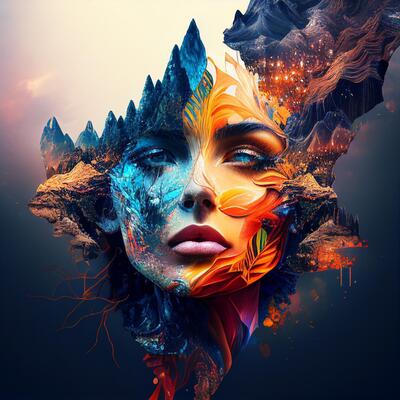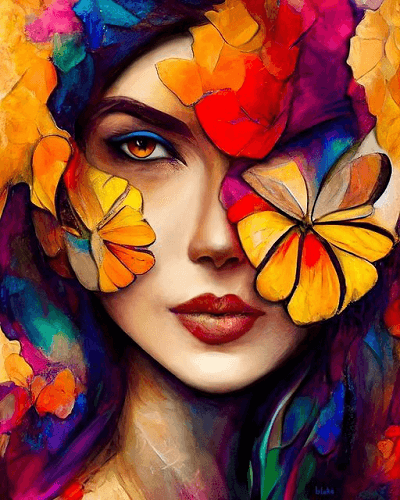The Function of Trump Art in Shaping Social Conversations Around Leadership
Wiki Article
Embarking on a Visual Trip With the Lyrical Analyses of Nature in Impressionist Landscapes
In the world of art background, the Stylist movement sticks out as a crucial period that revolutionized the way nature was depicted on canvas. Artists such as Claude Monet, Camille Pissarro, Edgar Degas, Berthe Morisot, and Vincent Van Gogh caught the significance of the natural globe via their one-of-a-kind analyses, producing landscapes that go beyond mere graph. Each brushstroke, each play of light and darkness, and each shade choice in their works speaks volumes concerning the artists' deep connection to nature and their capability to equate its elegance onto the canvas. As we discover the lyrical interpretations of nature in Stylist landscapes, we are invited to submerse ourselves in a world where fact and emotion intertwine, using a glance right into the musicians' extensive gratitude for the environment.The Captivating Brushstrokes of Claude Monet
Claude Monet's mastery of brushstrokes transcends mere method, imbuing his landscapes with an aerial top quality that fascinates and astounds audiences - trump art. His ingenious usage of color and light, combined with his distinctive brushwork, develops a feeling of activity and life within his paintings. Monet's distinguished collection of works showing water lilies and his famous haystacks display his capacity to catch the short lived effects of light and atmosphere
Enjoying Light and Darkness With Camille Pissarro
Embodying a similar respect for the interplay of light and shadow, Camille Pissarro's creative vision unfolds as an unified expedition of the environment's luminous nuances. Pissarro, a key number in the Impressionist motion, masterfully caught the dynamic connection between light and darkness in his landscapes. His proficient use of color and brushwork enabled him to convey the refined shifts in light that define various times of day and periods.Pissarro's paints often feature spotted sunshine filtering system through fallen leaves, casting elaborate patterns of light and darkness on the planet listed below. In works such as "Hoar Frost, the Result of Snow, Pontoise," Pissarro skillfully portrays the crisp illumination of winter season sunshine juxtaposed with the trendy shadows that specify the snowy landscape. By embracing both light and shadow in his compositions, Pissarro invites visitors to immerse themselves in the all-natural elegance and transient results of light on the planet around them.

Through Pissarro's jobs, we are advised of the transformative power of light and shadow, inviting us to pause and appreciate the short lived minutes of charm existing in the day-to-day landscapes that surround us.
A Symphony of Color Styles by Edgar Degas
Edgar Degas coordinates a dynamic harmony of colors in his masterful artworks, infusing his make-ups with a dynamic interaction of hues that captivate the customer's look. Understood largely for his ballet dancers and intimate scenes of Parisian life, Degas expertly adjusted colors to convey state of mind and motion in his paintings. trump art. His usage of strong, contrasting shades and refined tonal variations created a feeling of depth and vibrancy within his jobsDegas' color combination frequently consisted of rich blues, deep greens, and cozy oranges, which he applied with confident brushstrokes to catch the significance of his subjects. Whether representing a ballerina mid-performance or a team of pals conversing at a coffee shop, Degas' colors not just showed the scene however likewise evoked a sense of emotion and power.
In Addition, Degas' experimentation with light and darkness included an added layer of complexity to his color compositions, improving the overall environment of his paints (trump art). Via his experienced control of shade, find out Degas created an aesthetic harmony that continues to resonate with viewers today
Checking out Nature's Peacefulness With Berthe Morisot
Berthe Morisot's creative vision provides a calm departure from the lively color symphonies of Edgar Degas, as she captures the harmony of nature in her evocative landscapes. Known for her delicate brushwork and intimate representations of day-to-day life, Morisot's landscapes exhibit a sense of peace and consistency.Morisot's paintings often feature soft, soft tones that share a sense of peace and tranquility. Her jobs, such as "The Cradle" and "Summer season's Day," display her capability to record the subtle charm of nature in a method that is both comforting and reflective to the customer.
Unlike a few of her Stylist counterparts that concentrated on strong colors and dynamic structures, Morisot preferred to develop mild, introspective scenes that welcome the audience to mirror and pause. Through her skillful use light and shadow, Morisot develops a feeling of serenity that reverberates with the customer on a deep emotional level.
The Emotional Landscapes of Vincent Van Gogh
Vincent Van Gogh's landscapes vividly share a deepness of emotion through their dynamic brushwork and expressive use shade. The Dutch post-impressionist artist is renowned for his ability to capture intense and raw feelings in his paints, transcending conventional depictions of nature. Van Gogh's troubled personal life, marked by mental health battles, substantially affected his art, instilling his landscapes with a feeling of unease, melancholy, or pep.In works such as "Starry Evening" and "Wheatfield with Crows," Van Gogh's swirling brushstrokes and dynamic shade selections evoke a profound psychological feedback from customers. The rough skies and upset landscapes in his paintings mirror his inner chaos and emotional turbulence, welcoming viewers to look into the complexities of his mind.
Van Gogh's distinct visual language, defined by overstated point of views and vibrant use color, creates landscapes that resonate with visitors on a deeply emotional level. With his art, Van Gogh welcomes us to see nature not simply as an exterior reality yet as a mirror of our innermost sensations and anchor feelings.
Final Thought
Finally, the impressionist landscapes of artists such as Claude Monet, Camille Pissarro, Edgar Degas, Berthe Morisot, and Vincent Van Gogh use a fascinating and one-of-a-kind aesthetic analysis of nature. With their use brushstrokes, light, shade, and feeling, these artists have created a symphony of photos that evoke a feeling of peacefulness and charm in the all-natural globe. Their our website jobs remain to influence and captivate visitors with their lyrical interpretations of the landscapes around us.Each brushstroke, each play of light and darkness, and each color selection in their jobs talks quantities concerning the musicians' deep link to nature and their capacity to convert its elegance onto the canvas. His ingenious use of shade and light, incorporated with his distinct brushwork, creates a sense of movement and life within his paintings. His proficient usage of shade and brushwork allowed him to share the subtle changes in light that define various times of day and seasons.

Report this wiki page